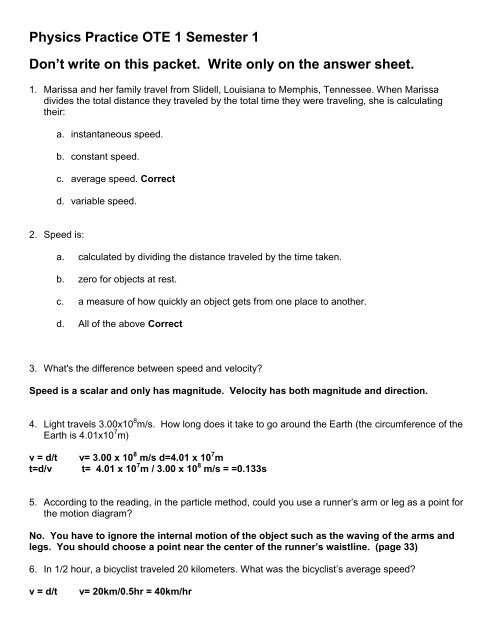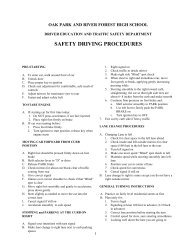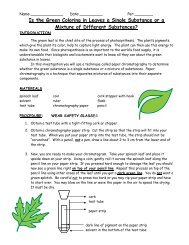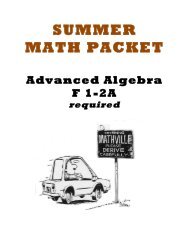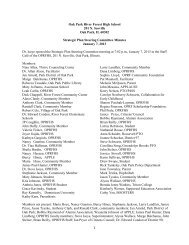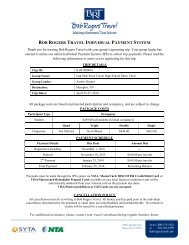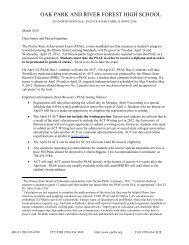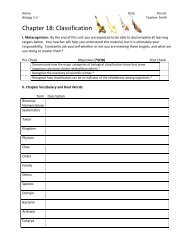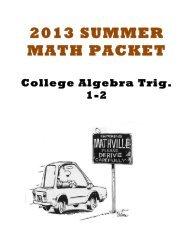Physics Practice OTE 1 Semester 1 Don't write on this packet. Write ...
Physics Practice OTE 1 Semester 1 Don't write on this packet. Write ...
Physics Practice OTE 1 Semester 1 Don't write on this packet. Write ...
Create successful ePaper yourself
Turn your PDF publications into a flip-book with our unique Google optimized e-Paper software.
<str<strong>on</strong>g>Physics</str<strong>on</strong>g> <str<strong>on</strong>g>Practice</str<strong>on</strong>g> <str<strong>on</strong>g>OTE</str<strong>on</strong>g> 1 <str<strong>on</strong>g>Semester</str<strong>on</strong>g> 1<br />
D<strong>on</strong>’t <str<strong>on</strong>g>write</str<strong>on</strong>g> <strong>on</strong> <strong>this</strong> <strong>packet</strong>. <strong>Write</strong> <strong>on</strong>ly <strong>on</strong> the answer sheet.<br />
1. Marissa and her family travel from Slidell, Louisiana to Memphis, Tennessee. When Marissa<br />
divides the total distance they traveled by the total time they were traveling, she is calculating<br />
their:<br />
a. instantaneous speed.<br />
b. c<strong>on</strong>stant speed.<br />
c. average speed. Correct<br />
d. variable speed.<br />
2. Speed is:<br />
a. calculated by dividing the distance traveled by the time taken.<br />
b. zero for objects at rest.<br />
c. a measure of how quickly an object gets from <strong>on</strong>e place to another.<br />
d. All of the above Correct<br />
3. What's the difference between speed and velocity?<br />
Speed is a scalar and <strong>on</strong>ly has magnitude. Velocity has both magnitude and directi<strong>on</strong>.<br />
4. Light travels 3.00x10 8 m/s. How l<strong>on</strong>g does it take to go around the Earth (the circumference of the<br />
Earth is 4.01x10 7 m)<br />
v = d/t<br />
t=d/v<br />
v= 3.00 x 10 8 m/s d=4.01 x 10 7 m<br />
t= 4.01 x 10 7 m / 3.00 x 10 8 m/s = =0.133s<br />
5. According to the reading, in the particle method, could you use a runner’s arm or leg as a point for<br />
the moti<strong>on</strong> diagram?<br />
No. You have to ignore the internal moti<strong>on</strong> of the object such as the waving of the arms and<br />
legs. You should choose a point near the center of the runner’s waistline. (page 33)<br />
6. In 1/2 hour, a bicyclist traveled 20 kilometers. What was the bicyclist’s average speed?<br />
v = d/t<br />
v= 20km/0.5hr = 40km/hr
7. You and your friend each drive 50.0km. You travel at 90.0km/hr and your friend travels at<br />
95.0km/hr. How l<strong>on</strong>g will your friend have to wait for you at the end of the trip?<br />
d = 50.0km v you = 90.0km/hr v=d/t so t=d/v t you = 50.0km/90.0km/hr = 0.556hr<br />
d = 50.0km v friend = 95.0km/hr t=d/v t friend =50.0km/95.0km/hr = 0.526hr<br />
t you -t friend = 0.556hr – 0.526hr = 0.029hr = 1.8min<br />
8. Which positi<strong>on</strong> vs. time graph below shows the slowest speed?<br />
9. You walk 20.0m east then turn around and walk 15.0m west. What is your displacement from<br />
your starting positi<strong>on</strong>?<br />
Total distance = 20.0m + 15.0m = 35.0m BUT Displacement depends <strong>on</strong> directi<strong>on</strong>. If we use<br />
East to be positive: +20.0m + (-15.0m) = +5.0m east<br />
10. Gwennen rides her bicycle 4.8 kilometers up a steep hill in 8 minutes. Her speed is ____<br />
kilometers per minute. (4 points)<br />
a. 0.3 km/min<br />
b. 0.6 km/min Correct<br />
c. 1.67 km/min<br />
d. 38.4 km/min<br />
11. Two cars are moving with the same speed. The velocity of both cars will be the same if the cars<br />
are moving in: (4 points)<br />
a. circles.<br />
b. opposite directi<strong>on</strong>s.<br />
c. straight lines.
meters<br />
d. the same directi<strong>on</strong>. Correct<br />
14<br />
12<br />
Positi<strong>on</strong> vs. Time<br />
10<br />
8<br />
6<br />
4<br />
2<br />
0<br />
0 50 100 150 200 250 300<br />
sec<strong>on</strong>ds<br />
12. Which moti<strong>on</strong> diagram below corresp<strong>on</strong>ds to the positi<strong>on</strong> vs. time graph above? (circle all that<br />
apply) Both A and D could be correct. There are no scales <strong>on</strong> the moti<strong>on</strong> diagram, so<br />
either <strong>on</strong>e could be correct. B and C show a change in speed and there is no change in<br />
speed <strong>on</strong> the graph.<br />
13. Circle all the vectors in the following list:<br />
a. 5 m scalar<br />
b. 30 m/sec, East vector<br />
c. 5 mi., North vector
meters<br />
d. 20 degrees Celsius scalar<br />
e. 256 bytes scalar<br />
f. 4000 Calories scalar<br />
35.0<br />
Positi<strong>on</strong> vs. Time<br />
30.0<br />
25.0<br />
20.0<br />
15.0<br />
10.0<br />
Student 1<br />
Student 2<br />
Student 3<br />
Student 4<br />
5.0<br />
0.0<br />
0.0 10.0 20.0 30.0 40.0 50.0 60.0<br />
sec<strong>on</strong>ds<br />
14. Which student <strong>on</strong> the above graph shows the highest average speed for the entire race<br />
(48 sec<strong>on</strong>ds)?<br />
1 2 3 4<br />
Student 1 has the steepest slope.<br />
15. Which student was farthest from the origin at the beginning (time = 0.0s)?<br />
1 2 3 4<br />
Student 4 was 30m from the origin at the beginning.<br />
16. Which student <strong>on</strong> the above graph is moving backwards (moving closer to the origin)?<br />
1 2 3 4<br />
Student 4 has a negative slope and is getting closer to the origin.<br />
17. At what time did student 1 and student 4 meet?
meters<br />
a. 0.0s<br />
b. 30.0s<br />
c. 32s<br />
d. 48s<br />
e. They d<strong>on</strong>’t meet.<br />
f. You can’t tell from the data.<br />
C is the best answer. The two students at the same distance from the origin at 34s.<br />
18. Why was it important to use layers for building your paper tower?<br />
Layers give more strength and allow you to build higher.<br />
19. If you were allowed to use 50 sheets of paper, how could you have built a taller tower?<br />
Answers will vary, but you should be able to build a str<strong>on</strong>ger and wider base so you could add<br />
layers. Think about it. You could come up with at least three different things you could do.<br />
18<br />
16<br />
14<br />
12<br />
10<br />
Positi<strong>on</strong> vs. Time<br />
A<br />
B<br />
8<br />
6<br />
4<br />
2<br />
0<br />
0 50 100 150 200 250 300<br />
sec<strong>on</strong>ds<br />
20. Will the two objects in the positi<strong>on</strong> vs. time graph above meet? If so, when?<br />
They will meet at 100 sec<strong>on</strong>ds. You can tell because that is where the graphs intersect or the<br />
two are at the same positi<strong>on</strong> at the same time.
meters<br />
10<br />
9<br />
8<br />
7<br />
6<br />
5<br />
4<br />
3<br />
2<br />
1<br />
0<br />
Positi<strong>on</strong> vs. Time<br />
0 5 10 15 20 25<br />
sec<strong>on</strong>ds<br />
21. For the positi<strong>on</strong> vs. time graph above, how far does the object move between 5 and 10 sec<strong>on</strong>ds?<br />
At t=5sec<strong>on</strong>ds dist=2 meters. At 10 sec<strong>on</strong>ds d=4 meters. Total distance = 4m-2m = 2m<br />
22. Which moti<strong>on</strong> diagrams (particle model) below, show an object slowing down?<br />
C. the distance is decreasing for every equal time interval.<br />
23. From a positi<strong>on</strong> vs. time graph how can you find the average velocity between two times?<br />
You find the slope of the line drawn between the two points <strong>on</strong> the best fit line at the times<br />
indicated.
24. If the average speed of a drag racing car is 0.069 miles per sec<strong>on</strong>d, how l<strong>on</strong>g would it take the car<br />
to complete a 1/4 mile (0.25 mile) straight track?<br />
a. 0.020 sec<strong>on</strong>ds<br />
b. 0.28 sec<strong>on</strong>ds<br />
c. 3.6 sec<strong>on</strong>ds Correct .25mi / 0.69 mi/s = 3.6s<br />
d. 3.5 hours<br />
25. A steeper line <strong>on</strong> a positi<strong>on</strong> vs. time graph means:<br />
a. a slower speed.<br />
b. a c<strong>on</strong>stant speed.<br />
c. a faster speed. (a faster speed)<br />
d. instantaneous speed.<br />
26. Which point <strong>on</strong> <strong>this</strong> positi<strong>on</strong> vs. time graph has the fastest speed?<br />
a. Point 1<br />
b. Point 2 (steepest slope = a faster speed or shortest time for l<strong>on</strong>gest<br />
distance)<br />
c. Point 3<br />
d. Point 4<br />
27. From the reading, which axis is the independent variable usually plotted?<br />
a. Vertical<br />
b. Horiz<strong>on</strong>tal Correct<br />
c. It doesn’t matter.<br />
d. There is no independent variable <strong>on</strong> a graph.
28. Using the following data, make a proper graph in the grid below. Please ensure it is proper in all<br />
manners.<br />
Distance in<br />
cm<br />
Time in<br />
Sec<strong>on</strong>ds<br />
0 0<br />
0.28 5<br />
0.84 15<br />
1.12 20<br />
1.4 25<br />
1.96 35<br />
2.24 40<br />
2.8 50


